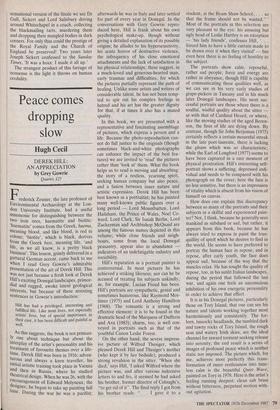Night and silence, who was there?
Frances Partridge
WHITE CHAPPELL, SCARLET TRACINGS by lain Sinclair
Goldmark, £12.50
JACK THE RIPPER by Peter Underwood
Cassell, £11.95
JACK THE RIPPER, 100 YEARS OF INVESTIGATION by Terence Sharkey
Ward Lock, £10.95
JACK THE RIPPER, SUMMING UP AND VERDICT by Colin Wilson and Robin Odell
Bantam Press, £12.95
THE COMPLETE JACK THE RIPPER by Donald Rumbelow
W. H. Allen, £14.95
Five books about Jack the Ripper! Surely this is .a little excessive even though next year marks the centenary of his exploits, and it might be supposed that we had supp'd full with enough horrors during the last decade for the most ghoulish appetite to be satisfied by reading the newspaper. Yet I believe there are few people who have never felt a twinge of curiosity about this famous mystery. Is it because it remains unsolved, and probably always will, like that of the Marie Celeste? Does it have the fascination of a beautifully constructed Agatha Christie or a difficult chess problem? Or does its attraction merely relate to the terror of dark alleys, sinister lurking figures, and the silence and savagery with which the murders were carried out. In any case the story has been gripping enough to inspire Mrs Belloc Lowndes's famous novel The Lodger, several films and an enjoyable opera by Phyllis Tate.
One of my five is a novel and can be quickly disposed of: White Chappell, Scar- let Tracings is the first publication of Goldmark Press, sumptuously printed in Verona (limited edition £100) and with enthusiastic advance blurbs. 'This novel refreshes, invigorates and cheers you up,' says one. Well — the heroes are 'four impressively seedy booksellers' and the text is rich in disgusting descriptions of vomit, spittle, snot and venereal sores. My verdict is that it is pretentious rubbish.
Peter Underwood may also be dis- carded. After reading that he has more than 20 books about ghosts and the occult to his credit, one is not surprised to find him treating the pronouncements s of mediums as serious contributions to the Ripper problem.
Terence Sharkey's book has several fea- tures to recommend it. It is clear, concise and well-organised. Beginning with a lively account of the five murders, he goes on to deal with the letters in the case (some purporting to be from the Ripper), and ends with an 'Identity Parade' of possible suspects, and 'Pick your Ripper', wherein he ventures to quantify the probabilities, and I am inclined to agree with his choice of favourite. It is illustrated by amusing line-engravings from the Police News of the day.
Of the last two items on my list, Colin Wilson and Robin Odell make an uneasy pair. By going over the ground again and again they muddle the issue and leave one with the impression that two books have been hastily clamped together. Donald Rumbelow's Complete Jack the Ripper is a thoroughly revised version of a book first published in 1.975. The author is a serving City of London policeman and lecturer on criminology; his forthright style suits the subject, and he claims to include new material that has 'recently surfaced', such as a letter from the doctor who carried out two of the post-mortems and read of the others. His interesting conclusion was that all five murders were undoubtedly by the same hand, and showed clear signs of sexual mania but not of scientific know- ledge (thus scotching the evidence against Queen Victoria's doctor, Sir William Gull, Neil Cream and several other mad medi- cos).
Rumbelow also gives in full the notes on the case made by Sir Melville Macnaghten of the CID, which have directed suspicion towards Montague Druitt. A bright boy from Winchester with a scholarship to Oxford, Druitt failed as a barrister and was sacked from a crammer's at Blackheath where he was teaching. Shortly after the last Ripper murder his body was fished out of the Thames and a suicide note found among his papers declared that he felt he was going mad 'like mother'. (She was in an asylum.) 'He was sexually insane,' Sir Melville commented in his notebook, 'and from private information I have little doubt that his own family believed him to be the murderer.' He had access to instruments in a cousin's surgery half a mile from Whitechapel. And there were no more Ripper murders. Pretty thin? No doubt, but much less fantastic than the story promoted by a television programme in 1973 and supported by Joseph Sickert, who claimed to be the natural son of the artist Walter. He said he had been told by his father — a well known farceur — that Queen Alexandra had arranged for her son Eddy to take lessons in Art in his studio; that while there he had met, got with child and married a Catholic shopgirl, whose prostitute friends took to blackmail. Sir William Gull's help was requested by the agitated Prime Minister, and in the most sensational version of the finale we see Dr Gull, Sickert and Lord Salisbury driving around Whitechapel in a coach, collecting the blackmailing tarts, murdering them and dropping their mangled bodies in dark corners. For only thus could the prestige of the Royal Family and the Church of England be preserved! Two years later Joseph Sicken confessed to the Sunday Times, 'It was a hoax: I made it all up.'
The strangest product of this farrago of nonsense is the light it throws on human credulity.











































































































 Previous page
Previous page